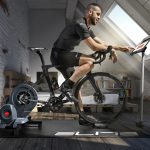Turbo trainers are the cyclists’ new best friend when it’s hard to get outside. These mechanical masterpieces work by simulating the rolling resistance you would experience outdoors, only indoors! In this informative guide, we describe how to set up a turbo trainer, so it’s ready for some serious indoor cycling adventures.
How do turbo trainers work?
Before we get into the nuts and bolts of fitting your turbo trainer, it’s worth looking at the two types available: wheel-on turbo trainers and direct-drive turbo trainers.
Wheel-on models use your existing rear wheel to attach to the turbo trainer. Your back tyre presses against a rolling platform that applies resistance. It’s this friction between the tyre and the turbo that’s crucial. They’re often cheaper than direct-drive units.
On a direct drive turbo, you remove your rear wheel and connect the frame directly to the machine and hook up your chain to the cassette that’s mounted on it, for most direct drive turbo trainers you have to buy and fit the cassette separately. The turbo trainer uses a flywheel to provide resistance. The flywheel on the turbo provides resistance and provides a more accurate feeling of the road for many cyclists.
The choice of which turbo trainer is right for you depends on your bike, your riding style and the size of your wallet. The good news is that both trainers will give you an excruciating workout if you’re brave enough!
What do I need?
You should set up your turbo in the place you want to use it because once you’ve fixed your cycle to the trainer, it’s difficult to move.
Without the wind in your face and on your body, you’re going to sweat a lot while turbo training, so consider investing in a turbo trainer mat and a fan. If pennies are tight and you want to save some money, place some towels or protective sheets on the floor. This will also stop any mud or grease from your bike getting ground into the floor surface.
Discover turbo trainer accessories
Setting up a wheel-on turbo trainer
Clear enough space to set up your turbo and move the roller backwards to make room for the wheel. You should be able to provide enough pressure with your hands. Don’t try and force it!
Next, position the rear wheel spindle into one of the sockets and then clamp in the other side. The clamps themselves aren’t set, you’ll need to adjust them with your hands to ensure that the bike is held securely. This may involve a little trial and error to get right.
Standard quick-release skewers that come with a bike will most likely not fit snugly in the clamps, however, almost all turbo trainers come with their own skewers that should be used so that there is no risk of slippage or damage whilst on the turbo. Most skewers that come with the turbo trainers should be long enough to accommodate both rim brakes and disc brakes, however on the occasion that your rear dropouts are too wide then there are extra long quick-release skewers that are sold separately to accommodate this.
Once your rear wheel is secured to the turbo trainer it cannot move but depending on the turbo trainer brand there will be some sort of latch or ratchet on the platform to help it rise up to meet the tyre. Different manufacturers will have different guidelines on how much pressure is required to calibrate this connection and we recommend referring directly to those specific instructions for best results I.E. realistically simulating the resistance of roads.
If you’re worried about your expensive tubulars becoming wasted, you can buy special turbo trainer tyres for use indoors. The key issue with tyre pressure is to be consistent as different pressures will affect the level of resistance & slippage when sprinting and create inconsistencies between sessions. Find a pressure (between 90-120psi) that is comfortable and creates the right levels of resistance. Too little pressure can create a heavy and laboured pedal stroke and the smell of burning rubber whilst too much pressure could result in tyre slippage when you are out of the saddle sprinting. Once you know this tyre pressure, make a note of it and make sure your tyre is always at this level when you start a session. All tyres are different so if you get a new tyre you will have to go through this process again.
When your back wheel is set up, you’ll need to use a riser at the front to raise your front wheel too to ensure that it’s level. We recommend that you invest in a turbo trainer wheel riser rather than a DIY solution, as it’ll keep you – and your precious bike – protected from slips, falls and accidents.
Explore our wheel-on turbo trainers
Setting up a direct-drive turbo trainer
Before we get started, check that you’ve got the same number of sprockets on your direct drive turbo as you have on your bike. The difference between 10 and 11 might not seem much, but a 10-speed chain won’t fit properly on an 11-speed cassette (and vice-versa).
Once you’re happy, remove the rear wheel from your bike. Put the chain onto the smallest cog and release the quick-release lever. Now, push the rear derailleur back and lift the frame. The rear wheel should slide out. Be careful while doing this and ensure your spokes don’t get caught or damaged in the rear cutout.
Take the bike to the turbo and gently lower it into place. Pull the derailleur back and slide the chain onto the smallest cog and place the bike gently onto the quick-release skewer.
Make sure that the bike is level on the turbo, and isn’t at an angle. As well as interfering with the smooth running of the chain, poor alignment could potentially damage the frame too.
Tighten up the quick-release skewer, so the bike is held securely. A good tip is to tighten it enough that when you clip it into place, it leaves a white mark on your hand. Any tighter and you could cause damage, and looser, and there’s a risk it could pop off while you’re riding.
Your turbo should come with a set of axle adaptors that will enable it to work with bikes fitted with through axles.
Some direct turbo trainers require you to have a raised front wheel, others don’t. Before you start putting some pressure through the pedals, read the instruction manual or check out the manufacturer’s website.
Explore our direct drive turbo trainers
So, now you know how to set up a turbo trainer. The next step is to climb on and get pedalling!
For everything you need to keep your bike in perfect condition, including bike servicing and free bike checks, head over to Halfords.com or pop into your local store, where one of our experts will be happy to help.

